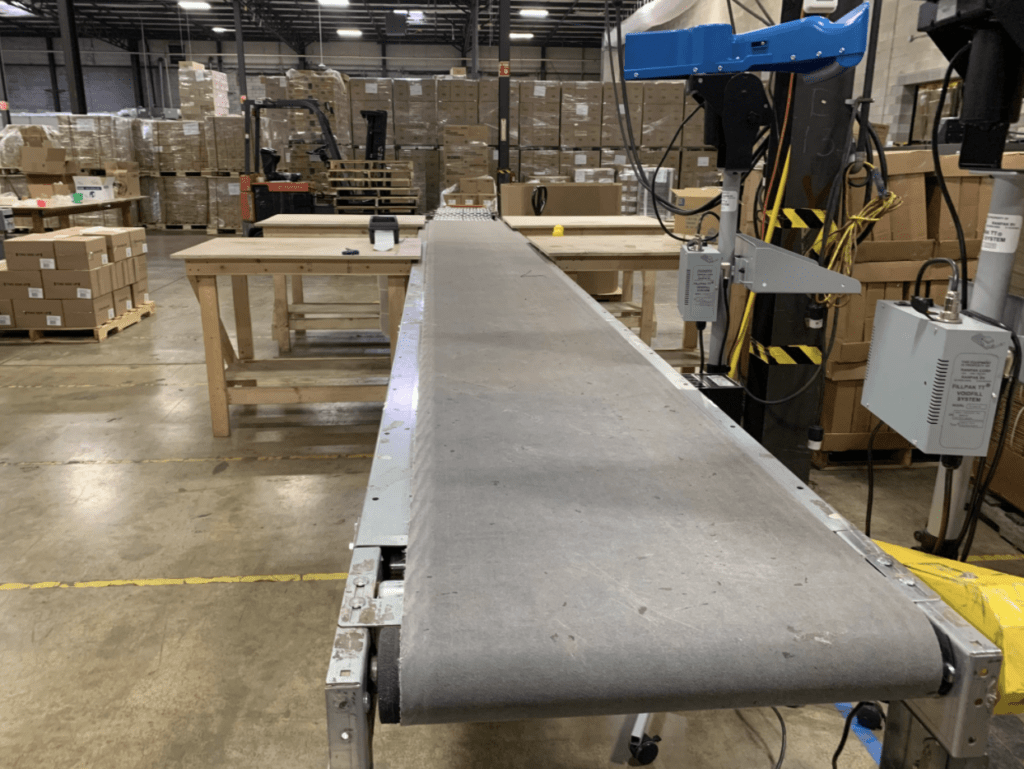57% of companies think supply chain management gives them a competitive edge. Warehouse slotting is a key piece of this chain. More than just arranging inventory, slotting is a strategic approach to increasing operational efficiency.
Check out our guide to everything you need about warehousing for faster fulfillment.
As logistics experts, we know that not incorporating slotting can increase the risk of errors, which can cause customer dissatisfaction and impact your business’ reputation.
Anita Patel, Ware2Go’s WMS Fulfillment Strategy Manager, explains how its new warehouse slotting SOPs help merchants get their products to their end consumers faster and more efficiently.
Keep reading for everything you need to know about warehouse slotting, the different types, and best practices.
What Is Slotting?
Warehouse slotting is the process of determining the best location within a warehouse to store inventory. The best warehouse slotting strategies use data about a product’s size, weight, and storage requirements, consider the SKU velocity compared to other products in the warehouse, and consider the pick path that warehouse employees will take to get to the item to optimize the layout and efficiency of the warehouse.

What Are the Different Types of Warehouse Slotting?
Choosing the right warehouse slotting strategy is essential for optimizing your operations. Here are the main strategies, each designed to enhance efficiency and productivity:
- ABC Slotting: Based on revenue and profitability, stores popular products closest to the picking line and less popular ones further away. This speeds up picking and increases productivity.
- Dynamic Slotting: This system adjusts item positions based on SKU velocity and seasonal demand to minimize picking time. High-priority items are placed at the front for easier access.
- Fixed Slotting: This system assigns a specific space to each product, which remains unchanged until manually adjusted. It is ideal for stable inventory environments with consistent demand.
- Zone Slotting: Divides the warehouse into areas for specific categories to improve organization and reduce travel time, enhancing safety and efficiency.
- Ongoing Slotting: Continuously fine-tune inventory placement based on seasonal changes, consumer demands, and storage needs to optimize the warehouse layout.
Each technique suits different operational needs. For example, fixed slotting works well in stable environments, while ABC slotting is best for prioritizing high-revenue items.
Why Is Proper Warehouse Slotting Important?
Anita Patel’s experience implementing Warehouse Management Systems (WMS), educating users, and optimizing internal processes has taught her one invaluable lesson about how data and physical operations go hand in hand: Any WMS is only as effective as the data you feed it. The most advanced system will fail if given improper data, and the most capable labor force will make mistakes if the system fails.
That’s why warehouse slotting is the key to efficiency, fulfillment speed, and order accuracy. It’s the first step in creating data integrity from the moment a piece of inventory hits the loading dock. If the first step is deliberate and the right data is gathered and logged from the beginning, it feeds efficiency downstream through the entire process, and warehouse automation can do its job.
The other element is the human one. No matter how far automation advances, the work of picking and packing will always need some element of human touch. A properly slotted warehouse enables staff to do their job as efficiently and accurately as possible. Slotting doesn’t just make your staff’s lives easier, but also your customers’. Because slotting streamlines order fulfillment and reduces errors, your customers will receive their orders on-time and error-free.

The Benefits of Warehouse Slotting
Warehouse slotting provides several benefits, including:
1. Economy of Movement
When high-velocity SKUs are stored closest to the packing station, pickers aren’t taking extra steps back and forth to pull the same SKU off the shelf hundreds of times daily. Their highest velocity SKUs are right at hand.
2. Efficient Use of Equipment
Slotting popular SKUs near each other that require different pieces of equipment (i.e., a piece that requires a forklift next to a piece that requires a cherry pick) is a recipe for traffic jams and time-wasting extra movements.
3. Decrease in Damages
Pickers should be able to do their jobs quickly without giving extra thought to configuring items in the box. Placing lightweight or delicate items at the end of the picking line ensures they’re handled last, reducing the risk of damage during transit. This also prevents users from rearranging the entire box, maintaining the integrity of the packing order. This decrease in damages reduces the chances of returns and customer complaints.

4. As Few Touches as Possible
If SKU velocity is considered the first time an item is put away, it won’t likely need to be moved later when the warehouse realizes it should be closer to the pack station. That means labor is focused on the most important part of their job: picking and packing, not re-organizing and relocating inventory.
5. Reduced Labor Costs
When you implement warehouse slotting, operational processes are optimized meaning you’ll reduce labor costs, benefitting your overall profitability.
6. Increased Safety
Warehouse slotting improves safety by placing heavy or hazardous objects in specific areas and clearing pathways for equipment and people.
7. Faster Deliveries
Slotting strategies reduce fulfillment time making it easier to fulfill consumer demands for fast shipping, increasing customer satisfaction, loyalty, and retention.
8. Accommodates Scalability
Slotting strategies optimize warehouse space for increased inventory volumes, reducing the need for costly upgrades. It can swiftly adapt to changing product mix and demand patterns, reallocating storage for fast-moving items or adjusting configurations for new ones. This ensures warehouses can handle higher order volumes without significant increases in labor or fulfillment costs.
Warehouse slotting speeds up order fulfillment time, increases profits, reduces labor costs, and maximizes productivity.
Getting Warehouse Slotting Data Right the First Time
You’ll need to assess relevant data to make the most of warehouse slotting. Ware2Go provides the following features to help collect the most important data sets:
- ADV and Velocity – Get this data at the SKU level. Sometimes merchants may be surprised to find that a single SKU within a product category is driving volume for that entire category. At Ware2Go, we also look at the entire SKU catalog to compare the velocity of one SKU to another when building a hierarchy.
- Product Profile – The practical data that determines what kind of storage space (shelving, bins, racking, etc.) and how much is needed: size, weight, transit type, and storage requirements. Those storage needs are the first consideration in our facilities with temperature and environmental controls.
- Kitting Requirements – This is essential to gather from the start. Items commonly purchased together should be close to each other to cut down on unnecessary steps.
- Promotion Schedule – Communicating promotion schedules around major shopping events like Prime Day or demand spikes specific to a merchant’s product line helps set warehouses up for success. Often, in the case of short-term promotions, a special project pick station is set up to get a high volume out in a short period.
All of these data sets are important to understand on a merchant-by-merchant basis, but we also have to consider them within the entire warehouse ecosystem. Ultimately, all merchants within the warehouse benefit when the entire space is used efficiently.

Ware2Go’s Slotting Best Practices
Ware2Go is committed to feeding efficiency downstream with our warehouse slotting strategy. We’ve developed several SOPs prioritizing data integrity and proper forecasting and planning to achieve this. These practices ensure that our slotting strategy optimizes warehouse space, accommodates fluctuating inventory volumes, and swiftly adapts to changing demand patterns, ultimately improving overall operational efficiency and customer satisfaction.
- Appointment Required for Inbounding – Our merchants schedule appointments for their inbound shipments so the warehouse knows exactly when and where the truck will arrive and exactly what will be in the shipment. This way, the warehouse knows the size, quantity, and storage requirements of products before they arrive and has the appropriate space prepped for them. This is key to quickly getting inventory off the dock and meeting our 48-hour dock-to-stock time SLA.
- Data Collected at Onboarding – We ensure we have solid data from the start to understand exactly how a new merchant’s inventory will fit into our current warehouse slotting systems. We ensure we have SKU profiles, average daily volume (ADV), and velocity. Some merchants may come to us with very little historical sales data, or they may be launching a brand-new product. We work closely with these merchants to create an accurate forecast and reassess once we’ve begun processing sales.
- Putaway Configuration – We use the SKU profile (including height, weight, and volume of the product) to determine the space requirements. Then, our WMS determines the best placement within the warehouse based on velocity and finds the putaway path with the least travel time for the warehouse employee.
- Decision Tree – We have standardized slotting decisions across our warehouses with a decision tree prioritizing warehouse placement by parcel vs. freight, ADV by SKU velocity, and SKU weight.

Warehouse Slotting FAQs
If you have questions about warehouse slotting, explore our FAQs for more information:
What Is Slotting?
Slotting is the process of finding the best locations to store inventory in a warehouse based on factors like product weight, size, and picking processes.
Slotting minimizes travel time for warehouse employees, reduces picking errors, and increases overall warehouse productivity by placing items in strategic locations.
What Is Ongoing Slotting?
Ongoing slotting is the process of continually adjusting warehouse inventory for maximum efficiency. This refers to factors such as the season, consumer demands, and storage requirements.
This strategic approach optimizes the warehouse layout to support changing consumer demands and business needs. Ongoing slotting often uses data analytics, warehouse management systems, and staff feedback to decide how to store products and improve overall warehouse productivity.
What Data Is Important for Warehouse Slotting?
Proper warehouse slotting requires data about the product’s storage needs, including quantity, size, weight, and environmental requirements. This data determines the type of storage and how much space is required. The data required to determine where in the warehouse a product should be stored are the average daily volume (ADV), relative SKU velocity, and kitting combinations.
What Is a Slotting Strategy?
A slotting strategy is a method a fulfillment center uses to determine its warehouse layout for ideal product storage. An effective slotting strategy will reduce travel time for pickers, reduce mis-picks, and improve fulfillment speeds.
Why Warehouse Slotting Matters for Merchants
Warehouse slotting plays a key role in supply chain management, increasing operational efficiency. Slotting gets orders to customers faster, reduces error rates, and increases order accuracy.
At Ware2Go, we’re committed to maximizing efficiency through our slotting strategy, ensuring that warehouses adapt swiftly to changing demand patterns and customer needs.
Are you looking for a fulfillment partner who can guarantee on-time and accurate delivery to your customers? Check out our services to see how we can fulfill your orders faster.




